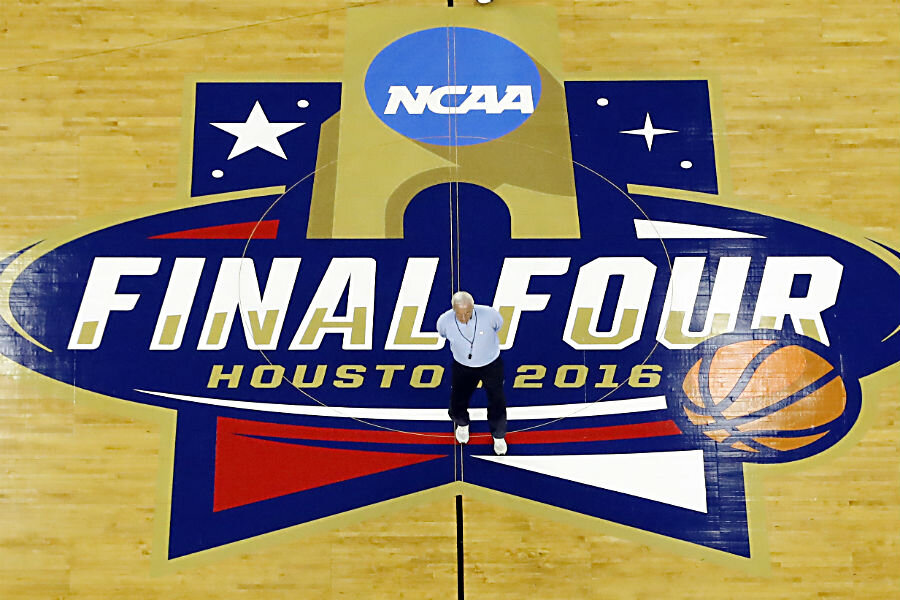NCAA 2016 Final Four TV schedule: Who, where, when to watch
Loading...
| Houston
Some things to watch for Saturday when Oklahoma meets Villanova and North Carolina faces Syracuse in the national semifinals at NRG Stadium:
MEET AGAIN: Rematches are far from rare in the Final Four but these four teams have three games between them this season.
Oklahoma blitzed Villanova 78-55 in Hawaii on Dec. 7, and as is expected on Saturday, 3-pointers were the difference.
The Sooners, led by Isaiah Cousins' 4-for-4 effort, went 14 of 26 while Villanova, with Kris Jenkins and Jalen Brunson both going 0-for-5, was 4 of 32 from beyond the arc.
North Carolina and Syracuse, both members of the Atlantic Coast Conference, faced each other in a home-and-home series and the Tar Heels swept the Orange.
On Jan. 9, Syracuse coach Jim Boeheim's first game back after a nine-game NCAA suspension over infractions, the Tar Heels prevailed 84-73 with Isaiah Hicks scoring 19 of his career-high 21 points in the second half. North Carolina scored 51 points and shot 64.3 percent from the field in the half. Trevor Cooney led the Orange with 27 points.
The game at Chapel Hill on Feb. 29 wasn't settled until the final 2 minutes when Hicks and Brice Johnson came up with big baskets for North Carolina. Johnson had 14 points and 10 rebounds. Michael Gbinije had 17 points for the Orange, who had a chance to tie the game in the final 15 seconds.
___
SHOOTING WOES: NRG Stadium has never been known as a shooter's haven.
In the six NCAA Tournament games played at the home of the NFL's Houston Texas — the 2011 Final Four and the 2015 South Regional — the teams combined to shoot 27.6 percent (59 of 214) from 3-point range. Plenty of teams have bad games, but only three teams in all of college hoops shot 27.6 percent or worse on 3s this season: Robert Morris, Grambling State and Prairie View A&M.
Only one team playing at NRG — Duke last year — shot better than 33 percent, and that was 42.1 percent (8-19).
Oklahoma (29-7) is coming into the Final Four shooting 42.8 percent on 3s — second in the nation — and Villanova (33-5) hits at a 35.4 percent rate. North Carolina has struggled this season at 32.1 percent while Syracuse shot 36.1 percent.
You'll know early if the shooters are struggling if the ball goes inside on every possession and the shooters are all driving to the basket rather than letting it fly from beyond the arc.
WHERE TO WATCH
Make sure you check your TV listings before tuning into the game. For the first time, the Final Four will be telecast on a cable station, TBS.
No. 2 Oklahoma vs. No. 2 Villanova is schedule to be broadcast at 6:09 p.m. Eastern.
No. 1 North Carolina vs. No. 10 Syracuse is scheduled to air at approximately 8:49 p.m.
TBS has shown early round and regional games but this will be the first time the national semifinals — and Monday night's championship game — will be on cable rather than over-the-air television.
The TBS announcers will be the same led by Jim Nantz with Bill Raftery and Grant Hill providing the analysis.
TNT will offer Sooners fans their own "team stream" play by play by Chad McKee, Eduardo Najera, and Jessica Coody.
Villanova fans can watch the action on the truTV cable channel with announcers Scott Graham, Brian Finnerand, and Kacie McDonnell.
Online streaming at: March Madness Live
___
COACHING WEAR
One of the four coaches will stand out and it will have nothing to do with winning percentage, titles or late-game situations.
Villanova's Jay Wright is considered the best dressed coach in college basketball. Oklahoma's Lon Kruger, North Carolina's Roy Williams and Syracuse's Jim Boeheim just aren't a match for the sartorial Wright.
"You have to a guy," Wright said. "You have to have a tailor."
___
IN THE ZONE
In both games, expect to hear a lot of talk about zone defense. Syracuse has been living and dying with its 2-3 zone for as long as Boeheim has been there — which is now four decades.
Villanova has also gone to a 2-3 zone often but its defense doesn't resemble Syracuse's even if the numbers are the same.
"I started to find ways we could still remain aggressive in it. That's why we're using it now. It's taken me a while to learn how we can be aggressive," Wright said. "With Oklahoma, the range that they can shoot the ball with, they play so far outside the 3-point line that even though you're in a zone, you got to go out and guard them, and it makes you play man-to-man. You can say you're in a zone, but you got to go out there to get them. If you go out to get them, you're man-to-man. They just spread you out so much."
Syracuse's zone is far from passive, but the Orange wait for the ball to move to an area and then they react with the sideline-to-sideline back line. There's another advantage to playing a zone defense.
"You tend to get fewer guys into big foul trouble with zone," Boeheim said. "In man-to-man, there's a lot of situations where teams are going to be isolated, driving. If you get a guy with two or three (fouls), they're going to try to isolate and drive that guy.
"You can't really do that against a zone, so we can protect guys better. Foul trouble is less of an issue for us, although it can be. But I think the number of players you use in tournament play goes down for everybody," he said. "We feel that we could bring another guy or two off the bench if we had to. But if we don't have to, we won't."
:







